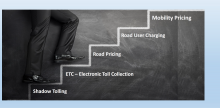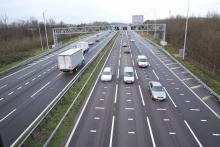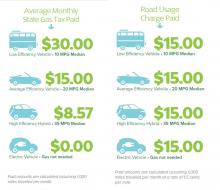
The first World Tolling Summit took place in Salzburg, Austria this autumn. Created and organised by the International Bridge Tolling and Turnpike Association (
The transfer of views, experience and practice both ways across the Atlantic plays a big part in the attraction of the event. IBTTA’s CEO Pat Jones explains: “Any time we can bring people together from different parts of the world I think it is a positive thing – allowing people to listen with new ears and see a new perspective on familiar challenges through somebody else’s lens. Those involved in tolling - the toll operators, the concessionaires, the vendors and consultants - can see there is a lot happening in the transportation sector and I think they are concerned the telecoms or technology com-panies could invade that space and take over.”
Grappling with change
The industry is grappling with all of this change and trying to see how it can position itself to be successful in a new and fast-changing environment, he continues: “This event is designed to help our people think about how they need to position their companies to remain relevant.”
With representatives from more than 30 countries in attendance, Sabine Kühschelm from Austria’s federal ministry of Transport, Innovation and Technology, told the opening session: “We have to question the old ways of maintenance, organisation and financing to ensure our transport systems will not face ever-increasing restrictions.”
She drew attention to the growing political impetus to enact the ‘User Pays’ and ‘Polluter Pays’ principles and how tolling systems may need to in-clude additional vehicle categories to differentiate, and impose additional charges on, more polluting vehicles.
This theme was picked up by Elisabeth Werner, director of land transport at
The European Commission has high expectations and wants ‘seamless mobility’ she said but added, “revenue from tolls and user charging only amount to 16% of the infrastructure costs in the EU, so where is the funding to come from?” While the importance in distance-based tolling is acknowl-edged, there is growing interest in other charges to minimise congestion and to recover the full cost of pollution. There is a trend to move from vi-gnettes to electronic tolling of networks across the EU. However, despite regulations, a lack of interoperability remains and still causes problems at borders.
Global perspective
Last year the EU added charging of cars into its proposal to facilitate distance-based charging, along with the introduction of ‘user pays’ and ‘polluter pays’ principles as happens with trucks.
Member states can decide not to charge but if they do, this should be done in accordance with the principles the EU has defined. For trucks, this in-cludes a move from the NOx and particulate-based ‘Euro standards’ for setting toll rates, to a emissions basis for toll calculations and the EU is keen to extend this to cars and vans, too.
The EU has drafted guidance on calculating the external costs for pollution and has given a general welcome for congestion charging, saying the in-come should be earmarked for transport rather than the general exchequer with regular reporting of the use of revenue.
A session examining the different challenges facing toll operators in other parts of the world provided a truly global perspective. This included a presentation from Karen Strougo, CEO of
While demand was growing, surrounding infrastructure prevented expanding the existing highway, so it was decided to introduce free-flow elec-tronic tolling and remove barriers on the manual cash lanes to increase throughput. Despite fears that violation rates would skyrocket, this did not happen in the cash payment lines - although unregistered drivers did start using the electronic toll collection (ETC) lane to bypass the queue and cut into the cash lane or avoid the toll altogether by driving on through the electronic lane.
Removing the barriers from the manual/cash lanes speeded the throughput by five to six seconds per transaction, and while adding barriers to the ETC lanes has slowed the processing registered vehicles are sensed at a distance from the barriers so there is no need to come to a stop.
“And it works for Peru,” Strougo told her audience. Not only does it prevent violations, it has also increased the incentive for drivers to register and get a tag and she said the solution could work in other parts of the world where there is little or no regulation to support the collection of tolls. “Using tolls to fund infrastructure is a perfect solution for countries that don’t have the money to do everything they need to do. We managed to intro-duce the new section in Lima and collect tolls without a riot because we showed the value we were giving to the population of the city,” she concluded.
News from Istanbul
Istanbul is famously the city where Europe meets Asia on either side of the Bosphorus and it has been home to some of the worst traffic congestion in the world (ranked sixth most congested in 2016 by TomTom). Burak Isik, investment development manager with
private ownership of the $3.5bn project. Forming part of the 160km Northern Marmara Motorway, the 2.1km bridge enables through-traffic (particu-larly heavy trucks) to avoid the middle of Istanbul. It was opened in 2016 and its 59m wide deck carries a rail line and four lanes of traffic in each direc-tion. Isik said after the new bridge opened, the average traffic speed on the second bridge increased by more than 50%.
Previously Turkey’s government had funded motorway building and the General Directorate of Highways (KGM) operated the network and levied a toll of $1c/km. However, there was minimal enforcement for non-payers and the collection rate was only around 80%, he told the delegates.
Investors in the new privately-funded scheme carry the collection risk which cannot be passed to the operating company but in return get state-funded compensation for any shortfall in the guaranteed traffic revenues. The existing windscreen sticker and independent pre-pay on-board unit (OBU), purchased through post offices, can be used on the new bridge but the toll rates are eight times higher than the state system.
Unlike the state motorways, each toll lane on the bridge can accept both electronic payment systems (minimising driver confusion, last-minute lane switching and lost revenue). Drivers can also pay by cash or credit card, although the delay is greater.
Isik said that following these changes, ETC has increased to account for 83% of transactions (10 million from 2.5 million subscribers) and non-payment has
dropped from 20% (pre-2016) to less than 1% today (after enforcement). Currently only 18% (two projects) of the country’s motorways are private-ly owned but with another 20 projects in the pipeline, this is expected to pass 70% by 2023.
In the following Q&A session, most speakers identified toll violation and avoidance as the biggest problem for tolling companies. Mike Heiligenstein from
other mechanism to fund a project but to go to the credit market and those guys expect to be repaid - yet the state has capped the maximum fine at $48 per year per account. A driver can decide to drive in our toll lanes a thousand times without paying and simply write a cheque for $48 at the end of the year.”
Radical solutions
In the ‘Optimising Mobility’ session, Christophe Boutin, executive director with French autoroute association ASFA, explained a radical solution to traffic congestion on the A1 northern approach between central Paris and the city’s Charles de Gaulle (CDG) airport. Not only does this route experi-ence considerable congestion and the rail network is running at capacity, but Paris will also host the Summer Olympics in 2024.
Planned investments include a CDG Express line, Grand Paris Metro lines and a new Pleyel crossroads station. In addition, a team of students was tasked with envisaging transport services and infrastructure opportunity to rethink transport along the corridor, to ease urban mobility in 2030.
Their solution was to use urban motorways to service areas where it is not viable to extend the metro and to transform the A1 into a linear inter-face to interconnect with new mass public transportation services. Four interchange stations along the A1 (starting some 20km from the city centre) would be used to allow people to park their private cars and switch in to car pool or autonomous shuttles and the Metro Line 17 currently under con-struction.
One of the lanes on the main carriageway would then be reserved for these shared services. This process is repeated at the second and third sta-tions with additional lanes reserved for the new services. Beyond the fourth station, all the lanes would be reserved for authorised services and the final stop would be the new Pleyel crossroads station where travellers can transfer onto the existing rail and metro services.
All in all, this was a prime example of the interchange of radical ideas and practical solutions that the IBTTA was seeking in staging the Salzburg event.
The Austrian experience
The move to a second generation of truck tolling by Austria’s tolling authority, Asfinag, was explained in detail by the organisation’s managing director Bernd Datler (pictured left). Having started tolling vehicles above 3.5t in 2004, the system was due an upgrade - but it was not a sim-ple task: Austria’s motorway network covers more than 2,200km (1,350 miles), has nearly 1,000 toll sections and almost one million vehicles fitted with an on-board unit (OBU). And with proceeds exceeding €1.3bn per year, outage had to be minimised or eliminated while interoper-ability with 28 types of OBU needed to be maintained.
“A ‘big bang’ changeover was not possible,” said Datler. “So the two systems had to run in parallel for a certain period.”
No jams
Preparation started in 2014 by separating the roadside equipment and back-office systems into separate tasks and in 2016 work got under way to fit the new equipment to the gantries with 10 crews fitting 20,000 new components to 500 toll stations. Most of the Kapsch-based technology was installed overnight and lane closures were minimised, enabling Datler to report that there were no traffic jams or accidents during this period. By mid-2017, the new back office system was under test and the system went live in the spring of 2018, with the hardware following a few months later – all without any revenue lost through downtime.
“What we have learned is that preparation must start early to define the capabilities of the new system and the architecture required,” he adds. “This is difficult if there is no in-house expertise and led us to separate the two systems [roadside and central] as we target two differ-ent markets.”
At its height, more than 50 Asfinag staff were working on the projects. Datler went on to say that excellent documentation of both the tendering process and the decisions taken proved to be vital - because objections to the tenders were quickly overcome as the documentation pinpointed the problems raised.
Less detail
With its own intellectual property on the central system, there was no need to migrate all the account details from one proprietary system to another: “It was challenging enough to change the technological basis of the system without migrating details of a million customers,” said Datler. He added that the new system cost less than half of the one it replaced and ‘next time’ the tender documents could be less detailed, and more resources would be focused on the central system.
Separately, Asfinag’s CEO Klaus Schierhackl (pictured below) told the World Tolling Summit that being a government-owned monopoly meant Asfinag could be open about all work and innovations as it has no need to maintain a competitive situation.
He stressed that Austria’s tolling ethos, which currently imposes an additional charge on trucks using the main motorways, will not be changed to a system that encourages drivers to use the smaller roads – a point reinforced by Austria’s minister of transport, Norbert Hofer.









